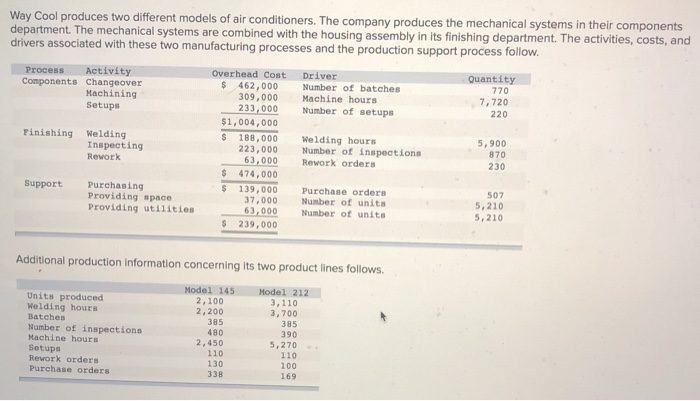Way Cool produces two different models of air conditioners. The company produces the mechanical systems in their components department. The mechanical systems are combined with the housing assembly in its finishing department. The activities, costs, and drivers associated with these two manufacturing processes and the production support process follow. Process Activity Components Changeover Machining Setups Driver Number of batches Machine hours Number of setups Quantity 770 7, 720 220 Finishing Welding Inspecting Rework Overhead Cost $ 462,000 309,000 233,000 $1,004,000 $ 188,000 223,000 63,000 $ 474,000 $ 139,000 37,000 63,000 $ 239,000 Welding hours Number of inspections Rework orders 5,900 870 230 Support Purchasing Providing space Providing utilities Purchase orders Number of units Number of units 507 5,210 5,210 Additional production Information concerning its two product lines follows. Units produced Welding hours Batches Number of inspections Machine hours Setups Rework orders Purchase orders Model 145 2,100 2,200 385 480 2,450 110 130 Model 212 3,110 3,700 385 390 5,270 110 100 169 338 Required 1 Required 2 Required 3 Determine departmental overhead rates and compute the overhead cost per unit for each product line. Base your overhead assignment for the components department on machine hours. Use welding hours to assign overhead costs to the finishing department. Assign costs to the support department based on number of purchase orders. (Round your intermediate calculations and per unit cost answers to 2 decimal places.) Show less Components department 0 Finishing department 0 Support department Model 145 Activity Driver Departmental OH Rate Total Overhead Cost 0 Components Finishing Support $ $ 0 0 Required 1 Required 2 Required 3 Determine the total cost per unit for each product line if the direct labor and direct materials costs per unit are $300 for Model 145 and $140 for Model 212. (Round your intermediate calculations and cost per unit answers to 2 decimal places.) Model 145 Model 212 Materials and Labor per unit Overhead cost per unit Total cost per unit Required 1 Required 2 Required 3 If the market price for Model 145 is $1,625 and the market price for Model 212 is $270, determine the profit or loss per unit for each model. (Loss amounts should be indicated with a minus sign. Round your intermediate calculations and final answers to 2 decimal places.) Model 145 Model 212 Market price per unit Cost per unit Profit (loss) per unit










